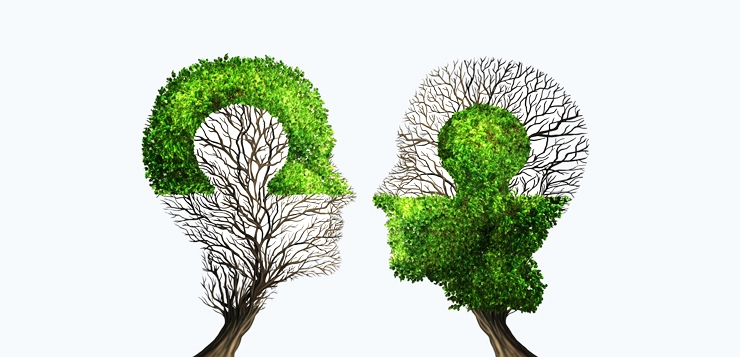
Self-awareness. Most of us believe we have a good measure of it. But how did we learn it? Is it just natural? If we had to teach someone to become more self-aware, how would we teach them? We know that self-awareness is good for personal growth and increasing well-being, but how many of us actually have a way to work on improving self-awareness?
One thing I have learned as an insight-oriented therapist is this: we are blind to aspects of ourselves. It can take years and even some crisis-experiences before we are able to fully realise the deeper parts of our hearts and minds. It is as if we are immune to negative feedback on those parts of us that we don’t like. But in order to grow with integrity-of-self coupled with a sense of freedom and authenticity, we need to get in touch with every part of our selves.
Over the years of work with clients and seminar participants, I have put together a useful and robust framework to help people develop deeper self-awareness. It is an abstraction and combination of different therapy modalities** into a simple acronym I call: The BET-RR Way. BET-RR [pronounced “better”] stands for: Body – Emotions – Thoughts – Reactions/Responses. Let’s talk about BET first.
BODY
Our brains are connected to our bodies. We can have a bodily knowledge of our state of being even before we are clued into it intellectually. For instance, when the room temperature rises, our bodies are already responding to the rising temperature before our minds are aware of it.
A more sophisticated example of this is the “gut-feel.” Our bodies somehow know what’s going on, but we can’t quite explain it. While the body does not reason quite as clearly as our minds can, sometimes, we ignore the intuitive signals our bodies give us to our own detriment — for example, trusting someone we had the sense that we should not have.
In order to have good self-awareness, we need to get to know the signals our bodies are giving us — the sense of tiredness, irritability, sadness, hunger, are all felt in the body. In order to get to know our bodies, we need to slow down and pay attention to what is going on.
Going deeper: Eugene Gendlin advanced the idea of having a “dialogue” with our bodies through a processed he called “focusing.” Watch this short video of Gendlin talking about the bodily “felt sense”.
EMOTIONS
The emotion is an interesting phenomenon that is something of a bridge between a body-sense and a thought. For example, it is not just body sense of “tension,” and neither is it a full formed mental opinion of “I don’t like this person in front of me.” An emotion is body-brain phenomenon that we label with words such as mad, sad, glad, scared, ashamed. Emotions come and go, but they provide incredibly important signals to what is going on inside of us.
Some people ignore emotions in order to push through to do the things they need to do. That can be OK for a while. But to keep on ignoring our emotions is like to ignore that odd sound in the car that keeps coming back — one day, we will break down, just like the car. Our ways of breaking down come in the form of smoking, drinking, over-eating, over-sexualising, addiction to social media, and even violence.
Developing self-awareness requires us to develop awareness of our emotions. Our emotions provide us with the more pure and honest answers to how we are dealing with things. One good way to develop emotions is to tap into our body sense and our language. The more words we have to describe what is going on for us in the body and emotion, the more refined we will be at self-understanding.
Going deeper: A few years ago, researchers mapped emotions to bodily sensations, and found similarities across cultures. Have a look at some of the findings.
THOUGHTS
I use the word “thought” to mean our reasoning or opinion-making. Between our bodies, emotions, and thoughts, we are likely to be most aware of our thoughts. This could be due to our need to talk about what we think so as to help others better understand us. So why would we need to develop more self-awareness of our thoughts? The answer is this: we are not fully conscious of how we reason or even the opinions we hold about something, especially the opinions about ourselves — our core beliefs.
Negative core beliefs, such as I am unlovable, I am defective, I live in a dangerous world, I am at fault, come from our early experiences. For example, if a woman growing up was badly teased about her looks, she may believe that she is defective somehow. Even though she might have become a very beautiful adult woman, that negative core belief may still be operating within her, and may even lead her to make decisions about her life that is not based on sound and objective reasoning.
Becoming aware of our core beliefs may take some work. It starts with taking a look at a list of core beliefs and seeing if any of these apply to us. Then, ask where those beliefs came from in our life experiences. Often, those who are closest to us may be able to give good feedback on the core beliefs that we operate with unconsciously.
Going deeper: In trauma work using EMDR, a very important component to the healing is to identify clients’ negative beliefs about themselves and help them move their negative beliefs to their preferred positive beliefs about themselves. Such movement is not to restate an opinion, it is a fully embodied shift in belief that is accompanied by positive emotions and body states.
REACTIONS / RESPONSES
When danger occurs, we enter into a Reactive fight-or-flight mode. It is a survival mechanism that allows us to act quickly without thinking — which might save us from being eaten by wild animals. But in today’s world filled with deadlines and expectations, our bodies operate in continual high-alert. For busy people focused on productive action on a daily basis, stress can cause us to be reactive without our awareness. That reactivity can then impact our closer relationships, the ones that we take for granted, such as our spouses, partners, and family members.
Becoming aware of our bodies-emotions-thoughts, and how they interact with each other, gives us a helpful mirror to the inside of ourselves. It allows us to catch our chronic-stress reactions, pause and think through our situation, and then choose well-reasoned Responses instead.
PUTTING IT TOGETHER
Over the past few months, I have been testing the BET-RR framework with different people and in training seminars. I am finding that it works well and people can understand it easily. But the most beautiful part about this framework — what gets me really excited — is that it can go really deep as well, especially when used by those who have practiced the BET-RR way over time.
Those who have grasped this framework have told me that they can see the BET-RR way applied to different life contexts: leadership, management, personal productivity, parenting, communication, marriage, addiction control, and the list goes on.
I will be developing this work further both in writing as well as through workshops and seminars. If you are interested in attending any public seminars that I will be giving on The BET-RR Way, come and follow my Facebook page (I don’t add strangers as friends, but you can follow my page) and you will see announcements posted up from time to time.
** In particular, I credit the work of Eugene Gendlin (Focusing), Cognitive Behavioural Therapy, and Francine Shapiro (EMDR).
—
© Johnben Loy, 2018. Unauthorized use and/or duplication of this material without express and written permission from this blog’s author and/or owner is strictly prohibited. Excerpts and links may be used, provided that full and clear credit is given to Johnben Loy and www.johnbenloy.com with appropriate and specific direction to the original content.

Jonben, I like your BET-RR model. It is a great way to help individuals to help themselves (applied). If you would like, I have a small piece of feedback, and that is to expound a bit more about the 2nd R – Response – in your description, as this is very likely where the “meat” is for transformative actions. That is, your model has the potential to help increase self-awareness, and the 2nd R (response) is the reason for the awareness…to make better choices of the informed choices available (rather than the 1st R – React). If you provide some examples here of responding rather than reacting, I believe it will provide an additional level of clarity (and teaching skills) for participants. Hope this is helpful! LOVE your work and contributions to others. Best, Jane
Hi JohnBen,
Thanks m keen to be your guinea pig though I’m born in the year of the rat!
Cheers
Kris